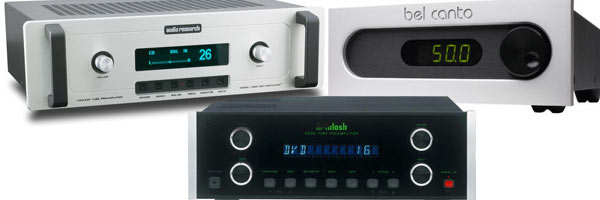
We will not be talking about the ability of these popular preamplifiers to transport you to musical bliss or to bring musicians into your listening room. This survey is not about the musical performances of these components and how the bass, midrange, treble, or soundstage is more or less like the “real thingâ€. Of course, the subject of fidelity to the original source is controversial because any sound recording engineer will tell you that even though they are closer to the actual musical performance than a listener at home will ever be, the sound in their control room, being recorded live, sounds very differently than the sound on the other side of the thick glass window.
Preamplifiers are the “necessary evil†of audio systems. Switching between sources could be accomplished with very minor sonic penalties. Controlling the volume without harming the extremely delicate audio signal, however, is the big challenge in designing a good preamplifier. The huge variety of volume control designs makes this point clearly: track-and-wiper potentiometers, discrete-resistor potentiometers (several configurations), switched resistor arrays (both IC and discrete), voltage-controlled amplifiers (VCA), multiple-winding transformers, and other technologies are available. Various techniques of dealing with voltage and impedance matching, such as vacuum tubes, transistors, linear buffers, transformers, and even optical transfer can be found. Each scheme has advantages and disadvantages both in terms of cost and performance, which implicitly means that any preamplifier using any of these parts is a compromise. Your mission, that you have accepted, is to decide which of these compromises are acceptable to you based on your personal view of how you like your music to sound, and what is financially possible.
Besides source switching, the goal of a stereo preamplifier is to provide the widely accepted function of being a straight wire with gain, imposing absolutely no character, change, distortion, or any alteration of the audio signal. The most reliable way to evaluate how successful a preamplifier is at attaining this goal is with bypass testing. Bypass testing allows for adding or removing only the preamplifier from an otherwise unchanging playback system, allowing precise audio inspection of the intrinsic sound of the preamplifier and any deviations from neutrality.
| Review continued on 10Audio.com | next…. |
About 10Audio
| 10Audio content is shared with the consent of 10Audio. Don’t know about 10Audio? Check them out. Here is 10Audio’s hi-fi philosophy. “This site is by audiophiles for audiophiles. Our experience includes more than 30 years of audio sales, DIY, and consulting services. So if you are interested in another “qualified” opinion, please read on.You won’t find any advertising so impartiality is assured. Sometimes it takes a while to post a review. Thank you for your patience. This site is BS-free, which, as you know, is an entirely relative statement.” www.10Audio.com |









Leave a Reply